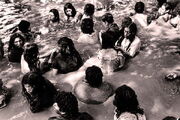
Curanderismo

Plaza del Mercado de Rio Piedras
By: Ana Villarreal
Curanderismo refers to the Spanish word curar, which means "to heal." This term "is used to describe the practice of traditional healing in Latin American (Hispanic) cultures" (Tafur, Crowe, and Torres 82). Curanderismo is derived from Greek humoral medicine, early Judeo-Christian healing traditions, Europe in the Middle Ages, Moorish influences from the conquest of Southern Europe, and Native American traditions (Trotter 130). The curandero/a believes that he/she is born with a talent to heal people, which is referred to as el don (a gift) from a higher power. Spirituality and maintaining balance with nature is the basis of curanderismo. Every curandero/a, or healer, may have a specialty of practice or a combination of all. To name a few, there are Yerbero/as (herbalists) with a concentration on botanical remedies, Parteras (midwives), Espiritualisto/as (psychic mediums), and Senor/as (tarot card readers). Many healers do not charge a fee for their services; they may accept offerings instead. Curanderismo involves three main healing practices: material approaches to healing, spiritual healing and spiritualism, and psychic healing. Some common traditional illnesses of curanderismo are empacho (digestive blockage), susto (soul loss), and mal de ojo (evil eye). The botanica (herbal market) is another essential component to

Botanica Los Sueños
curanderismo. After a curandero/a diagnoses the patient, he/she prescribes a remedy for the illness. The patient may need a medicinal herb, specific rock/stone, candles, religious amulets, and/or oils. The items he/she may need depends on his/her illness, so it varies for each patient. When the patient becomes aware of the necessary items, he/she may visit the botanica to purchase the items. In one article, I learned that the botanica served as a culturally appropriate health care resource for Latinos.

Botanica La Nueva Milagrosa - Union City, NJ
I believe curanderismo is very important. There are many people living near the border that put their faith in the healing practices of curanderismo. For example, studies conducted in West Texas have found that more than 75% of Mexican Americans use complementary or alternative therapies to treat their illnesses (Tafur, Crowe, and Torres 83). Also, in some of the scholarly articles that I found, I discovered that Latinos do not feel confident to discuss complementary and alternative medicine with their primary care physicians. 69% of Mexican Americans do not report the use of herbal remedies to their physicians (83). There were three main themes that I found for this lack of communication between patients and their primary care physicians: acceptance/nonjudgment, initiation of communication, and safety/efficacy concerns (Shelley et al. 145). Therefore, Mexican Americans and Latinos are not likely to openly share their experiences on visiting a curandero/a with their physicians. In most cases, they do not even attempt to initiate a discussion on curanderismo because they are scared that the physician will respond in a negative way. So, I believe it is crucial for physicians to become informed and aware of these Latino beliefs in order to better understand the patient and make him/her feel at ease.
El Nino Fidencio[]
Full Name: Jose Fidencio Sintora Constantino
Birthplace: Valle de las Cuevas near Iramuco, Guanajato, Mexico
Nov. 13-1898 - Oct. 19, 1938

Mexico's Greatest Curandero

Performing Surgery

Performing Surgery
Healing Rituals in Espinazo, Mexico

El Charquito

El Charquito
Mal de Ojo (Evil Eye)[]
Belief: an intentional projection of ill will toward another
In reality, the person who causes it does not mean harm, but rather admires the person who comes to suffer from the ill effects of this person's regard (Torres 33).
This belief applies more to babies than adults.
With this belief, a baby may fall ill if an individual admires him/her and fails to touch the baby in order to neutralize the negative vibes from excessive admiration.
Curandero's Cure:
1. Use a fertile chicken egg to do a limpia (ritual sweeping) by rubbing the egg over the baby's body, especially his/her head and eyes. Be sure to hold the egg in your right hand while sweeping the baby.
2. Begin at the baby's head and proceed down his/her entire body. Include arms and legs. While you are doing the barrida (ritual sweeping), pray three Apostles' Creeds, or Credos.
3. Pray to God to remove all evil from the baby and to heal him/her. Crack the eggshell, dropping only the egg yolk into a clear glass of water.
4. Examine the egg yolk to see if you can spot what looks like an eye on the yolk or some other identifiable shape. If you can see what looks like an eye, that is a sign that negative energy of the evil eye has been absorbed by the egg from the baby. Once this occurs, the afflicted baby will settle down from what appears to be a frightening state of illness (Zavaleta and Salinas 153-154).

Nazars (Charms)

Belief Bracelet

Hamsa Hand

Hamsa Hand Bracelet
Common Medicinal Plants[]
Sabila (Aloe Vera)

For burns, wounds, rheumatism, gastric ulcers
Albahaca (Basil)

For digestive disorders, nervousness, menstrual cramps
Gordolobo (Cudweed) Manzanilla (Chamomile)

For colds, bronchitis, asthma, diarrhea

For menstrual cramps, colic, indigestion, insomnia
(Zavaleta and Salinas 384-397)
Related Films & Novels[]

2013 Film

Bless Me, Ultima The Trees, The Rocks, The River 2013 Movie Scene

1994 Novel
Works Cited[]
Bless Me, Ultima: The Trees, The Rocks, The River 2013 Movie Scene. YouTube. Web. 20 July 2014.
Curanderismo. YouTube. Web. 20 July 2014.
Gomez-Beloz, Alfredo, and Noel Chavez. "The Botanica as a Culturally Appropriate Health Care Option for Latinos." The Journal of Alternative and Complementary Medicine 7.5 (2001): 537-546. Web. 26 June 2014.
Tafur, Maritza M., Terry K. Crowe, and Eliseo Torres. "A Review of Curanderismo and Healing Practices Among Mexicans and Mexican Americans." Occupational Therapy International 16.1 (2009): 82-88. Web. 26 June 2014.
Torres, Eliseo, and Timothy L. Sawyer, Jr., ed. Curandero: A Life in Mexican Folk Healing. Albuquerque: New Mexico UP, 2005. Print.
Trotter, Robert T., II. "Curanderismo: A Picture of Mexican-American Folk Healing." The Journal of Alternative and Complementary Medicine 7.2 (2001): 129-131. Web. 26 June 2014.
Zavaleta, Antonio, and Alberto Salinas, Jr. Curandero Conversations: El Nino Fidencio, Shamanism and Healing Traditions of the Borderlands. Bloomington: AuthorHouse, 2009. Print.